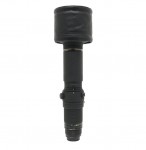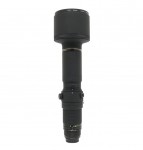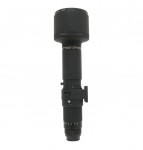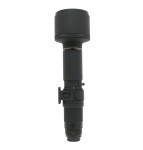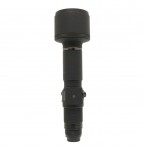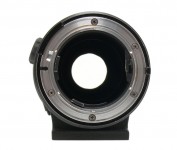Nikon AI-S Nikkor 800mm F/8 IF-ED
Super telephoto prime lens • Film era • Discontinued
- Announced:
- · December 1982
- Production status:
- ● Discontinued
- Country of design:
- · Japan
- Original name:
- · Nikon NIKKOR*ED 800mm 1:8
- Class:
- · Slow full-frame super telephoto prime lens
- · Professional model
- System:
- · Nikon F (1959)
Abbreviations
| AI-S | A manual focus lens with automatic maximum aperture indexing and automatic aperture control. Learn more |
| IF | Internal focusing. |
| ED | The lens incorporates low dispersion elements. |
Model history (4)
| ■Nippon Kogaku / Nikon Nikkor-P[·C] Auto 800mm F/8 | A | 5 - 5 | 19.00m | ⌀122 | 1964 ● | |
| ■Nikon Nikkor 800mm F/8 ED | A | 5 - 4 | 19.00m | ⌀122 | 1975 ● | |
| ■Nikon AI Nikkor 800mm F/8 IF-ED | A | 9 - 7 | 10.00m | ⌀122 | 1978 ● | |
| ■Nikon AI-S Nikkor 800mm F/8 IF-ED | A | 9 - 7 | 10.00m | ⌀122 | 1982 ● | |
Specification
| Optical design: | |
| 35mm full frame | |
| 800mm | |
| F/8 | |
| 9 elements in 7 groups | |
| 2 ED | |
| Internal focusing (IF) | |
| Nikon F [46.5mm] | |
| 3.1° (35mm full frame) | |
| On Nikon D APS-C [1.53x] cameras: | |
35mm equivalent focal length: | 1224mm (in terms of field of view) |
35mm equivalent speed: | F/12.2 (in terms of depth of field) |
Diagonal angle of view: | 2° |
| Diaphragm mechanism: | |
Diaphragm type: | Automatic |
Aperture control: | Aperture ring (Manual settings + Auto Exposure setting) |
| 9 (nine) | |
| Focusing: | |
| 10m | |
| <No data> | |
Focusing modes: | Manual focus only |
Manual focus control: | Focusing ring |
| Physical characteristics: | |
| 3300g | |
| ⌀134×452mm | |
| Accessories: | |
| Screw-type 122mm | |
Additional features: | Drop-in filter holder (39mm) |
| Built-in telescopic round | |
| Not compatible |
Sources of data
- Manufacturer's technical data.
- Nikkor lenses booklet (1984).
- Nikon dealer notebook pages.
- Nikon dealer catalogue.
Manufacturer description
Belonging to a new generation of super-telephoto lenses, the Nikkor ED 800mm f/8 IF offers unparalleled image quality and handling ease, plus automatic diaphragm operation. The use of Extra-low Dispersion (ED) glass in the lens design drastically reduces chromatic aberration (i.e., the inability of a lens to bring all wavelengths of visible light, especially red and blue, into the same plane of focus). The result is images that are crisp and virtually free of "color fringing" even when the lens is used wide open at its maximum aperture.
Nikon Integrated Coating (NIC) is applied to the surfaces of lens elements to reduce flare and improve contrast and color rendition.
For improved handling, this lens utilizes Nikon's Internal Focusing (IF) system, in which the lens elements are moved internally. Without the traditional focusing helicoid, there is no increase in the overall length of the lens as it's focused closer; thus, it is much easier to hand-hold. In addition, the lens is lighter and more compact than previous models at the same focal length. Other convenient features include a built-in telescopic lens hood, built-in tripod mounting collar, presettable focusing ring for rapid refocusing to a certain distance, and full aperture through-the-lens metering with Al-type Nikon and Nikkormat cameras*.
The ED 800mm f/8 IF has special insertion-type filter holders accepting either 39mm screw-in or gelatine filters-the same type used with the Reflex-Nikkor 500mm f/8 and 1000mm f/11. Because of its long focal length, this lens is perfectly suited for a wide variety of situations, including photojournalism, sports and wildlife photography, as well as taking pictures of the sun and moon itself.
* When using this lens with non-AI cameras, exposure should be measured by the stop-down method. (For details, refer to your camera's instruction manual.)
For maximum picture sharpness and freedom from camera shake, the use of a tripod is recommended at all times. The Nikkor ED 800mm f/8 IF is incorporated with a sturdy, full rotatable (360°) built-in tripod mounting collar for just such purposes. To attach to the tripod, position the collar tripod socket on the tripod screw and tighten. To rotate the lens (with attached camera) for vertical or horizontal format, loosen the collar locking screw, rotate the lens to the desired position, and retighten the locking screw to secure the assembly. For convenience while positioning, index marks are provided at 90° intervals around the tripod collar.
The focusing ring is fitted with a special ring for use when rapid refocusing to a specific object distance is desired; the click-stop action of the ring enables operation "by touch" for greater speed. To preset the lens, loosen the preset ring locking screw, rotate the focusing ring as far as it will go in either direction, turn the focusing ring back to the desired focus setting, and tighten the preset ring locking screw to set the click-stop position.
Depth of field (i.e., the zone of acceptable image focus) can be checked by reading the color-coded depth-of-field indicators engraved on the lens barrel. The pairs of colored lines on either side of the white distance scale index line correspond to f/numbers of the same color on the aperture scale. You can also observe the depth of field through the viewfinder by simply pressing the depth-of-field preview button on the camera body.
The Nikkor ED 800mm f/8 IF uses standard Nikon 39mm screw-in filters, mounted on a filter holder which is inserted into the body of the lens just behind the tripod mounting collar. To gain access to the filter holder for filter changing, press and turn the knob on the filter holder 90° counterclockwise until the white line on the knob is at right angles to the axis of the lens. The filter holder will come free and can be lifted out of the lens. Unscrew the filter and replace it with the one you wish to use. Lock the filter holder back in place by reversing the above procedure. A special filter holder is provided with this lens which accepts gelatine filters. To fit the filter, release the catch, flip open the filter plates, insert the gelatine filter, close the plates and cut off the excess with a sharp knife. The filter holder can then be mounted in the usual way. Please note that due" to a slight difference in thickness between gelatine and glass filters, some focus shift may occur when changing from one type of filter to the other; this discrepancy is easily corrected, however, by slightly shifting the focus setting. A filter must be mounted in the lens at all times.
Notes
- This AI-S lens was designed for Nikon FA, FG, N2000, N6000 AI-S cameras and Nikon F3, EL2, EM, FE, FE2, FE10, FG-20, FM, FM2, FM10, FM3A, Nikkormat FT3 AI cameras. The automatic aperture control will only be available on AI-S cameras.
- AI and AI-S lenses are backward compatible with Nikon F, F2, Nikkormat FS, FT, FT2, FTN, EL, ELW cameras.
- On Nikon digital SLR cameras, the automatic exposure metering with AI and AI-S lenses will not be available on D40, D40X, D60, D70, D70s, D80, D3000-D3500, D5000-D5600 series.
Other super telephoto prime lenses in the Nikon F system
Lenses with similar focal length
| ■Interchangeable mount (6) | |||||||||
| Century Tele-Athenar 800mm F/4.7 II | M | 4 - 2 | 18.00m | -- | 1977 ● | ||||
| Kowa Prominar 850mm F/9.6 FL | M | 14 - 13 | 3.00m | ⌀95 | 2010 ● | ||||
| Soligor 800mm F/8 (s/n 9xxxxxx) [T] | P | 2 - 1 | 25.00m | -- | ● | ||||
| Tele-Tokina 800mm F/8 [T] | P | 4 - 4 | 18.00m | -- | ● | ||||
| Vivitar Tele 800mm F/8 Type 1 [T] | P | 2 - 1 | 23.00m | -- | ● | ||||
| Vivitar Telephoto 800mm F/8 Type 2 (s/n 37xxxxxxx) [T] | P | 4 - 2 | 18.00m | -- | ● | ||||

